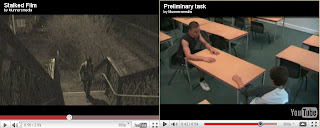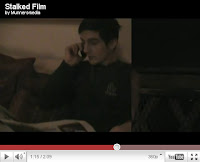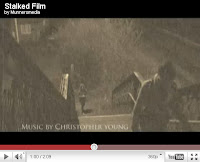- From producing our preliminary task we were able to learn how to use different techniques in media e.g the 180 degree rule, match on action and shot reverse shot.
- In our preliminary task we didn't use any editing other than just cuts between scenes, which we learnt isn't affective as the shots do not flow together then, so we introduced in our film beginning mainly fade in /fade out to black.
The above screen shots (the left is our preliminary, the right is our final product) show a close up shot. From using a close up of eyes in our preliminary task, we saw how it was an effective technique to use as it clearly shows the emotion of the character. As our character Lucy in our film is afraid, we wanted to highlight this and it was affective to show the shock through her eyes widening. The way we could make this the focal point of the shot was by displaying it in a close up.
The above screen shots display our use of shot reverse shot. In our preliminary task we used the technique of shot reverse shot as it shows each character when they are speaking in conversation. By using this technique the expressions of characters will be shown by their faces which are shown, this will also show their emotion in relation to what is happening in the conversation. In these type shots we also ensured they are over the shoulder shots so that the audience know who the character is speaking to by showing their shoulder. And also in these shots we used the 180 degree rule in which the camera stays on one side of the people. This technique ensures that the viewers do not get confused as to where characters are in a room/ location and where the other character is in relation to them.
Both our preliminary task and our final film display the technique of match on action.
Above is a screen shot of our preliminary task. These two shots display match on action as they show the character opening the door, and then the next shot carries that on rather than the door being closed and then reopening it again.
Above is a screen shot of our final film. This shows the technique of match on action as it shows the victim character being handed the 'lost cat' poster, and then in the next shot, she is seen holding it in the same position which is a clear match on action between shots.
The above two screen shots show a camera movement technique that we used in both of our filming tasks. In our preliminary we used the panning technique to show the movement of somebody through a location. As we saw how this worked well there, we decided to use it in our final film also, as we wanted to show the victim character running away, and by using a slight panning shot this technique clearly displayed this.
The above two shots show the use of a high angle shot. From using it in our preliminary (right) we realised that this was an interesting shot type to use, as it adds variation to a film along with showing more of the setting. Though, it isn't good for showing emotion which is what should be shown in this scene. So when using it in our final film (left), we used it for the victim walking up the bridge and unknowingly being followed. This shot type was affective here in comparison with the preliminary task as this shot doesn't have to display any emotion, meaning that it's good to use the high angle shot to display the location. The above screen shot shows the use of the 'wipe' editing technique in our final film. This ensured separation from the victim character walking to the phone conversation, so we used this editing technique at the beginning and the end of the conversation. In comparison, in our preliminary task we did not use any editing other than just cutting between scenes. This is because we had lack of editing knowledge at this time. It would have been affective in our preliminary to include some editing such as fade in from black (which we used in our final film) etc, as it begins and ends the film well. But by not have included these editing techniques, this shows how we have progressed.








No comments:
Post a Comment